14 Tips For Making The Perfect Pierogis, According To Natasha Kravchuk
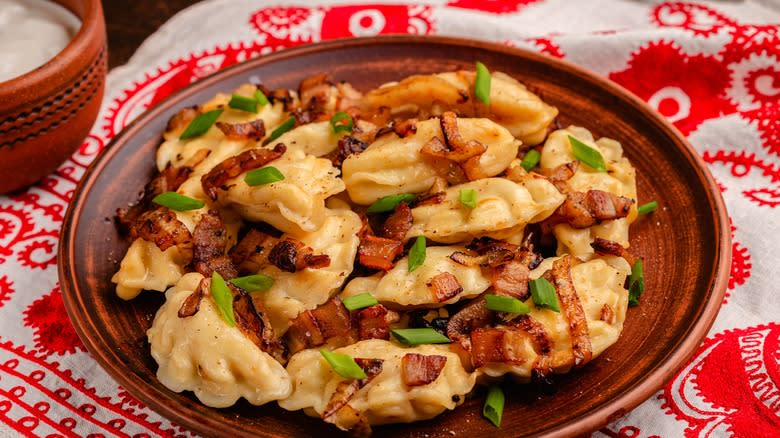
Pierogis are a quintessential part of Polish and Eastern European cuisine. However, the actual history of this dish is murky at best. There are a few origin theories about food being a gift for religious figures, or the food being brought from East Asia or China on the Silk Road or the Kievan Rus. Although historians can't agree on which is true, they can sure agree that pierogis are delicious. The dumplings, which are considered the national dish of Poland, are traditionally filled with mashed potatoes, fried onions, farmer's cheese, mushrooms, or vegetables, but there are also some variations calling for meat or sweet fillings. And unlike other foods in the Polish culture, these are eaten at all times of the year, including important holidays like Easter and Christmas.
Food writer and cookbook author Natasha Kravchuk knows a lot about pierogis. She currently runs her website, Natasha's Kitchen, where she shares the recipes from Europe and abroad she loves with her audience. As the daughter of Ukrainian immigrants, homemade pierogi are a staple in her house and appear in her most recent cookbook, "Natasha's Kitchen," which is slated to hit stores in October 2023. We had the opportunity to sit down and talk with Kravchuk about her tips for making delicious pierogis at home, perfect for eating any time of year.
Read more: 17 Types Of Potatoes And When To Use Them
Add Sour Cream To The Dough

Pierogi dough usually has several simple ingredients: flour, water, salt, oil, and egg. But for a little extra softness and pliability in the dough, Natasha Kravchuk also adds sour cream. "That's something my mom has always done," she shares. "It's a combination of the sour cream and the oil that will give you a soft, pliable dough that's easy to roll." As shared in her cookbook, Kravchuk's recipe for pierogi dough calls for one tablespoon of sour cream for each two tablespoons of oil. She adds the sour ingredient to the dough with the other liquid ingredients. If you're opting for a dairy-free recipe, Kravchuk notes you can substitute the sour cream with equal parts water.
Kravchuk's go-to choice for oil in her pierogi dough recipe is either light olive oil or standard vegetable oil. She notes that the former is her go-to choice for oils, but home cooks can also substitute other types of oil into the recipe interchangeably, as long as they don't impart any odd flavor notes on the dough.
Measure Out Your Flour Correctly For A Perfect Dough
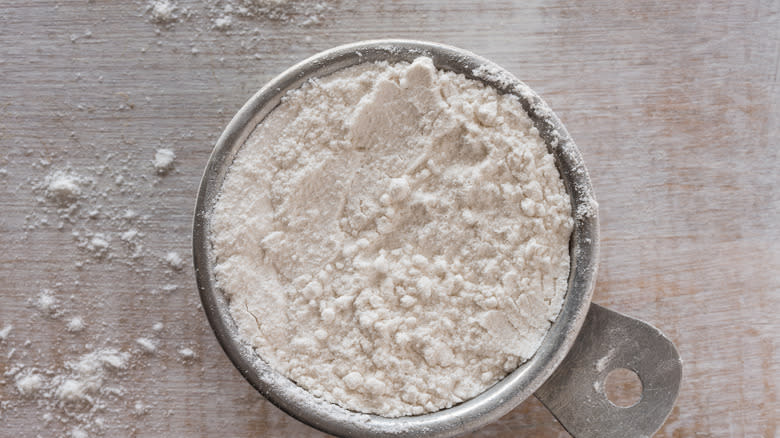
One of the biggest mistakes Natasha Kravchuk notices when people are working in the kitchen, regardless of whether they are making pierogis or not, is that they are improperly measuring critical ingredients in a recipe. At the beginning of her cookbook, she explains that the best way to measure flour for a recipe is to always scoop the flour into the measuring cup rather than going in with the measuring cup and compacting the dough. The latter method, she notes, can increase the amount of flour in the recipe by up to 25%. This fundamental methodology flaw can spell disaster for a recipe like pierogi dough.
"It's really hard to explain what the dough is supposed to look like if you haven't made it," she explains. Following the recipe to a tee and using proper measurement tools for wet and dry ingredients will ensure your dough comes out perfect every single time — even if you're a pierogi novice.
Stick To All-Purpose Flour

Experimenting with flour types is one way a home cook can put their own spin on a recipe. But, when working with pierogis, using a standard, all-purpose flour is important. Natasha Kravchuk explains that the all-purpose flour she recommends home cooks use for their recipe has a nuanced flavor, which will allow the fillings and the toppings to shine through, and has the perfect gluten content to form the pasta-like texture needed to encase the fillings.
Kravchuk admits she's never experimented with gluten-free flour blends for a pierogi recipe but would be concerned about how the texture of the pierogi would hold up, especially after cooking. She notes that her sister has tried making pierogis with einkorn flour, and the recipe turned out well, but this wheat flour has its own challenges because it has a different gluten and protein content than standard white flour. In turn, novices should stick with the standard all-purpose flour before experimenting with other types.
Use A Sturdy Potato For The Filling

The most easily recognizable filling for pierogis is undoubtedly potatoes. Natasha Kravchuk has several recommendations for what varieties of spuds work best for this recipe. She recommends using Yukon gold or Russet potatoes for pierogis because the heartiness of the potatoes really makes them easy to work with. Potato types that aren't as utilitarian for pierogis include waxy red potatoes or any variety that isn't really meant to be boiled.
Not only is your potato choice important, but also how you cook your spuds. "The key thing is not to overcook the potatoes and don't overboil them because then they tend to get waterlogged." Kravchuk peels her spuds and quarters them before adding them to the water to combat this phenomenon. Equally-sized chunks will further ensure that your potatoes are evenly cooked and ready to be mashed into your filling with your choice of cheese or meat.
Substitute Leftover Mashed Potatoes For A Quick Filling
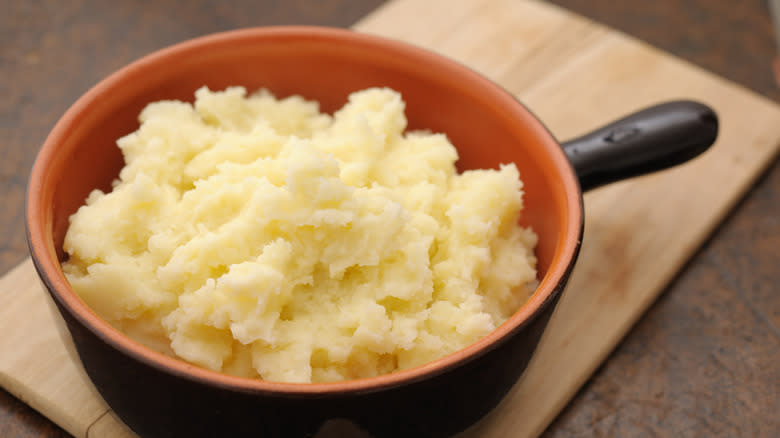
Taking the easy way out and making a simple substitution in your recipe isn't something to be ashamed of — it's actually just a testament to your resourcefulness. One of the best ways to use up leftover mashed potatoes is to stuff your pierogis with it.
Natasha Kravchuk recommends going with homemade mashed potatoes for this recipe rather than the boxed flakes that have been pre-cooked. She notes that homemade mashed potatoes will tend to harden when they're cooled, which is the perfect texture for making pierogis. "I would just re-mash them up a little bit by hand to loosen them up, but I wouldn't reheat them," Kravchuk recommends. She notes that you can use any mashed potatoes for this recipe, even if they contain butter, milk, or a creamy element like sour cream or crème fraîche.
Another shortcut that some people make with pierogis, but Kravchuk does not recommend, is using wonton wrappers instead of making your own dough. She notes that the wrappers get slimy when they're cooked, which can impart an unpleasant mouthfeel to the pierogi. Moreover, she shares that the texture of the wrapper is "not quite right" and not worth substituting, especially when the dough recipe is relatively foolproof.
Allow Adequate Time For Your Pierogi Dough To Rest
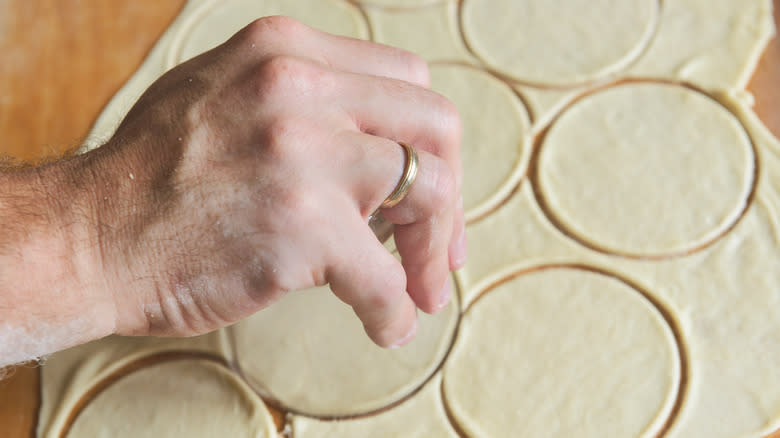
Rest is a critical aspect of making any dough, whether for pasta, pie, or pierogis. In the recipe published in her cookbook, Natasha Kravchuk recommends letting the pierogi dough rest for at least 30 minutes after you've brought it together into a ball. She notes that this rest time, although comparatively short to other dough recipes, is critical to allow the gluten in the dough to slack and relax. She notes that resting is also the remedy for a dough that is acting temperamental or when you've added just a bit too much flour to the recipe. Once your dough is rested, you can roll the dough out with a pin until it is about ⅛ of an inch thick. Then, use a 3-inch cookie cutter, jar lid, or glass cup to slice out your pierogi rounds.
Letting your dough rest isn't the only way to prevent a rubbery pierogi. Natasha recommends only mixing the liquids together with the flour for about two minutes or as long as it takes for the dough to become smooth and elastic. Any more work will cause the gluten strands to firm up and bounce back when the dough is rolled.
Be Deliberate When Filling Your Pierogis
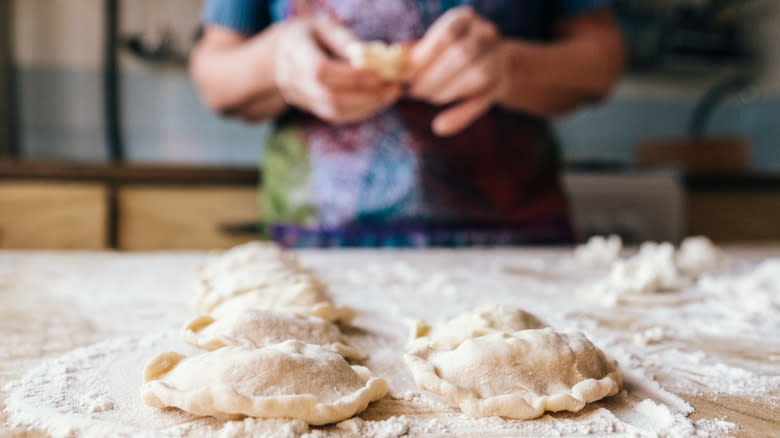
Arguably, the most difficult part of making pierogis is always stuffing and filling them. "No matter what kind of filling you're doing, sweet or savory, you want to make sure that the filling doesn't touch the edges of the dough," Natasha Kravchuk shares. "You want to keep the edges of the dough clean for when you seal them."
Besides giving each round adequate clearance, Kravchuk also recommends being mindful of how much flour you use to roll out your dough. Using too much flour on the surface, which will inevitably lead to the flour getting on the raw dough surface, will prevent you from sealing the pierogis effectively. Once you've rolled out the rounds, Kravchuk notes that you can tightly seal the edges of the dumpling together with your fingers or crimp it shut to give it an aesthetic upgrade. "Go over it a second time to ensure it's sealed completely," she recommends.
Freeze Your Pierogis Ahead Of Time For An Easy Dinner
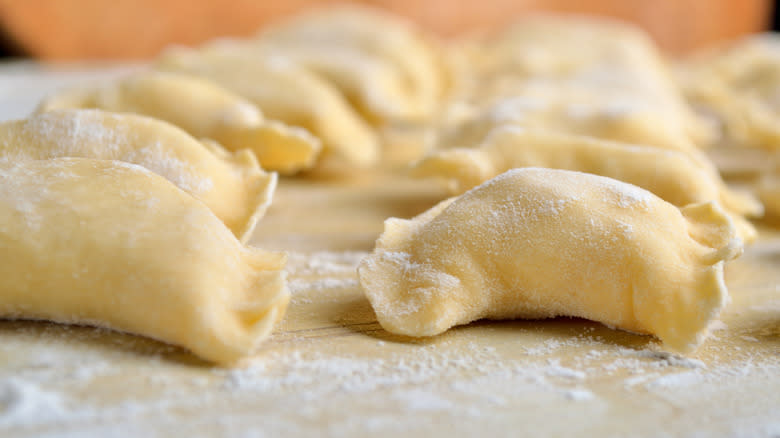
Pierogis can admittedly be a tough dish to throw together in a single night. Rather than making these dumplings on demand, Natasha Kravchuk turns to her freezer to prepare the recipe ahead of time.
Kravchuk starts by making the pierogi dough and her fillings. After she's stuffed and sealed each dumpling, she places them onto a floured baking tray so they are not touching one another. As she's making the pierogis, she's also careful to cover them to prevent the dough from drying out and altering its texture. Once the pierogis are finished, she places them in the freezer for a couple of hours until they're fully hardened. Then, she'll transfer the dumplings to a freezer bag for easier storage. Per Kravchuk, this method will allow you to have pierogis for up to about three months. When the craving hits, grab your pot of water and toppings and make it happen!
If You're Cooking Your Pierogis From Frozen, Don't Let Them Thaw Out First

Natasha Kravchuk notes that the best way to cook frozen pierogis is to always boil them from frozen rather than letting them thaw at room temperature before plunging them into the hot water. If you let the dough thaw at room temperature, the pierogis will tend to stick together and clump rather than float in the hot water independently.
Besides boiling your frozen dumplings, you can also use other techniques, albeit less traditional. Sauteing or pan-frying the pierogis will lend well to a crispy crust with pockets of crunch and softness. You can even cook your pierogis on the grill or pop them in your air fryer to get them to crisp up quickly with minimal effort. Regardless of the method you choose, you'll be rewarded with a warm plate of delicious dumplings that are just begging to be doused with sour cream.
Only Cook Your Pierogis Enough For Them To Float

Like cooking fresh pasta, pierogis are not made to be submerged in boiling water for long amounts of time. A quick dip in hot water will do the trick to cook the exterior of your dumpling, especially considering the filling is already cooked and good to go. Natasha Kravchuk recommends only cooking your pierogis long enough so that they float to the top of the water. This will ensure you get the perfect texture without your dumplings coming out spongy.
When she's cooking pierogis, Kravchuk only adds about half of the batch in at a time. This is especially important for frozen pierogis since too many dumplings will drop the temperature of the water and cause them not to rise to the top as quickly. Once the pierogis are finished cooking, she uses a wire spatula or strainer to fish out the dumplings, tosses them to dry, and then adds them to a serving plate. Removing the extra water is critical since it will prevent the dough from sticking to one another.
Get Creative With Your Pierogi Toppings
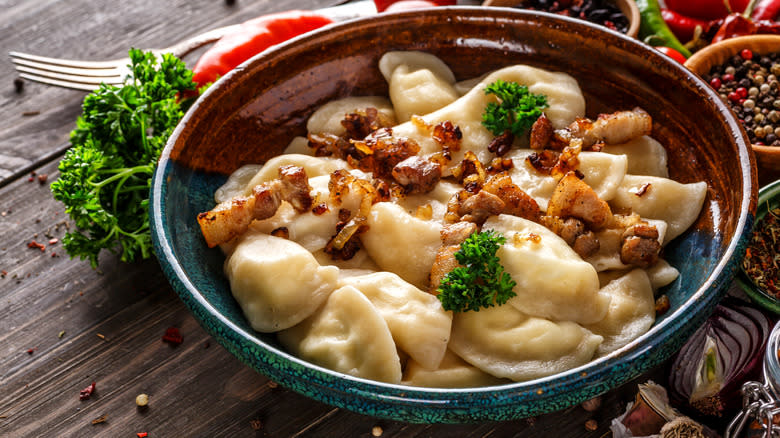
The filling of the pierogi rightfully deserves some attention, but it shouldn't be the star of the show. Pierogis are a dish where you can experiment with toppings to add a bit of crunch or freshness to the dish. The classic topping for most pierogi recipes, especially when filled with potatoes, is going to be a dollop of sour cream. But we also love the warmth and savoriness of caramelized onions that have been cooked in butter. The top tip for caramelized onions is to cook them low and slow; perfectly cooked onions can take up to 40 minutes to make. The good thing is, that you can focus on chilling your dough or making a dessert while occasionally stirring the onions.
One of Natasha Kravchuk's favorite toppings for savory pierogis is fresh dill. This herb adds a pop of color and flavor to an otherwise dense dish. "I think it's a combination of [all of the toppings] is just the best thing," she comments.
Experiment With Savory Fillings Like Vegetables, Meat, And Cheese
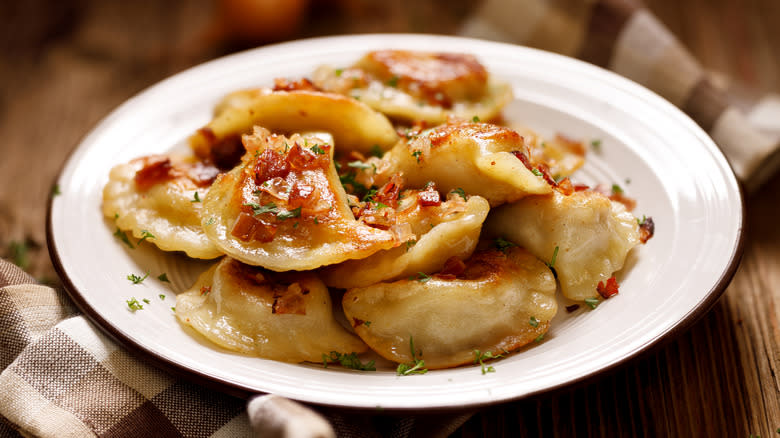
How do you decide what kind of filling is best for your pierogis? In short, it depends a lot on your personal taste. Natasha Kravchuk uses mozzarella cheese for her filling because she wants her kids to enjoy the pierogis. This Italian cheese is also a bit less flavor-forward than a sharp cheddar. "It's just my husband and I — we probably might be putting in some Gouda or some other fancy cheeses," she shares.
Mashed potatoes are arguably the most popular filling for pierogis, but you can also dress it up by adding some chopped green onion or caramelized onions to the potato mixture. Vegetable lovers will also love adding sauteed cabbage to their dumplings. Meat-based pierogi recipes can include salty and savory favorites like chopped bacon; just be sure to adequately cook the meat before adding it to the filling since the short cooking time won't be sufficient.
Coat Your Pierogis In The Serving Bowl To Prevent Sticking
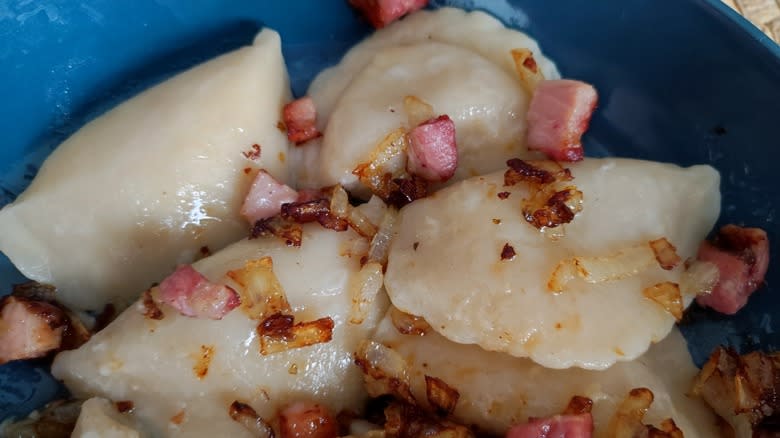
Since you've spent so much time and effort ensuring your pierogis are perfectly shaped and crimped, you don't want to get to the home stretch just to realize that all of your pierogis have stuck together in a single mass. To prevent this from occurring, Natasha Kravchuk recommends constantly coating the pierogis in oil or butter after you've shaken off the water used for boiling the dumplings.
"I like adding bacon bits for that little bit of savory bite," Kravchuk explains. She drizzles some of the bacon grease from her topping, along with butter, over her dumplings as soon as she transfers the dumplings into the baking dish. This grease infuses a mild, meaty flavor on the pierogis while using the grease that would otherwise be thrown into the trash. Butter or oil would also work well if you're making a meat-free recipe. For sweet pierogis, Kravchuk uses a sprinkle of granulated sugar to prevent them from sticking.
Make A Sweet Variation On Pierogis With A Stonefruit Or Berry Filling

There are so many opportunities to experiment with pierogis and adventure into fillings that aren't always savory. "I love the [sweet pierogis] every time we have fruit in season," Natasha Kravchuk explains. Her favorite sweet fillings include cherries, blueberries, and stonefruit-like plums.
The key to making fruit-filled pierogis is to avoid giving the fruit time for the moisture to seep out. To combat this, Kravchuk will sprinkle sugar on top of the fruit to soak any residual juice before closing the pierogi. She also doesn't mash the fruit into a filling like you'd find in a turnover or a pie, preventing moisture from seeping out of the fruit and into the dough. And although her fruit pierogi recipes utilize fresh fruit, there are also opportunities to use frozen fruit as a cheaper and more accessible alternative.
Read the original article on Tasting Table.

